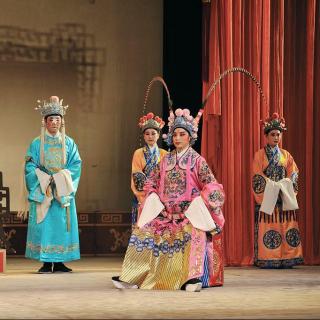
介绍:
Shaoju Opera is one of three traditional Chinese operas from Zhejiang. The art form goes back more than 1,000 years, having started as a ceremonial worship ritual. It later evolved into a folksy performing arts form. With high-pitched arias, basic, simple music, uninhibited performances and both civil and military characteristics, Shaoju opera certainly has its own unique artistic style.
Of the different kinds of shexi (社戏) operas, Shaoju is the most popular because of its strong country flavor, which is characterized by humor, acrobatics and over-the-top theatrics. Its unbridled expression of emotion and intense and highly engaging style of performance has obviously found favor with the local people.
Shaoju opera has about 400 tales in its repertoire, most of which are derived from folk tales and legends such as The Battle of the Tiger and the Dragon, The Cinnabar Ball and Life Flight, among others. Of these, the most popular is The Monkey King Thrice Defeats the Skeleton Demon, which is based on the ancient Chinese classic, Journey to the West. Featuring eye-catching kungfu techniques and mind-blowing stunts, this play is considered to have so much artistic value that it was made into a film which won praise both at home and overseas.
Shi Jie-jing (施洁净) is a Shaoju opera artist.
“Watching Shaoju opera is indeed an enjoyable experience. Sometimes, when I&`&m on my own, I indulge myself and just immerse myself in the opera. The music is beautiful and the singing is full of emotion. You get completely mesmerized by the opera.”
Singing is a dominant element of Shaoju opera, and is particularly famous for its melodies. The tunes are sweet and beautiful, while performances concentrate on being as vivid and full of local flavor as possible. But although this form of opera has developed, its basis in reality and everyday life, and the use of colloquial language, has remained a vital ingredient.
Shaoju opera is accompanied primarily by a wooden fiddle, sometimes supported by a small lute. The music is forceful and the singing style is exaggerated. Performers are not strictly limited by the music, but can embellish their arias according to the mood of the scene. Acting technique is characterized by large, bold gestures and stylized martial arts based on a local fighting method. Actors use a full voice range, from the natural to the falsetto. This larger-than-life performance style and energetic music is particularly suitable for the Shaoju repertoire of historical pieces, many of which give the actors the opportunity to display anger and portray struggle.
Shi Jie-jing again.
“You need to be really into the character and completely fill out the character with your emotional singing, convincing body language and facial expressions. It takes time and a lot of practice to master the finer nuances of each role.”
The performers need to be more than just expressive and agile on the stage. Shaoju opera is extremely physical and requires tremendous stamina to pull off. The actors need to perform all kinds of acrobatics, as well as mastering perfect martial arts skills. Performing 30 somersaults in one go in just one act is all part and parcel of the actor’s performance.
That is why Shaoxing locals still embrace the opera wholeheartedly, especially during festivals and celebrations to mark important occasions such as the worship of ancestors or the harvest season in the villages.
As a commonplace art form in the lower reaches of the Yangtze River, Shaoju has always been a major source of entertainment in rural areas. In the past, towns and villages in Shaoxing would invite traveling opera troupes to stage performances in their hamlets. Many of these shows would run for days on end.
As evening approached, the symphony of gongs and drums would grow louder, and the crowd would gradually increase in size in front of the makeshift stage. As the audience&`&s enthusiasm grew, they would quickly move in to find vantage spots to get a better look at the show.
Above the chatter and friendly guffaws, some would start to hum familiar opera tunes, telling others there that they had witnessed the show on previous occasions. Some of those gathered would stop to listen to the humming, while others would keep their eyes on the stage, waiting for the show to begin. Then, the music would start to climb to a crescendo, indicating an impending start. The crowd would quickly hush, and like children fascinated by a magic show, they would watch in rapture as the curtains parted and the amazing world of the opera came to life.
But inevitably, like many traditional performing arts, Shaoju is also worrying about its survival in the face of the many modern forms of entertainment that are flooding the country. Here is Shi Jie-jing again.
“What we should do is to keep going, especially in difficult times. We have to face new challenges and pressures to keep the art alive and relevant. At the same time, we must get ourselves ready for reforms and changes, making adjustments and introducing new acts into the repertoire to attract a wider audience.”
Followers hope that with the efforts of dedicated Shaoju artists like Shi Jie-jing, this traditional Chinese theater will deflect the onslaught of modernity; and continue mesmerizing its audiences.
大家还在听

